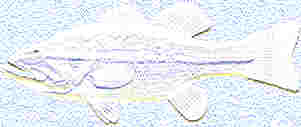

Yellowstone National Park's fishing season opens on May 24, 1997. Many anglers anxiously await this annual event; fishing in the park has a reputation that attracts people from around the world. While fishing has always been a popular pastime in Yellowstone, fisheries management has changed dramatically since the early days of the park.
Historically, about 40 percent of park waters were barren of fish, including most of the lakes. Native Americans made do with that situation, and there is evidence (projectile points and notched stones used as net weights) that those people used the resources of the Yellowstone Lake area nearly 10,000 years ago. But, in the late 1800s, for many Americans of European heritage, including early park administrators (the U.S. Army Cavalry) and the U.S. Fish Commission (predecessor to today's U.S. Fish and Wildlife Service), the lack of fish in park waters was unacceptable. Captain Frazier Boutelle, in charge of the park from 1889-1891 commented, " . . . I hope to see all of these waters so stocked that the pleasure-seeker in the Park can enjoy fine fishing within a few rods of any hotel or camp."
The goal of park management in that day was to stock as many waters as were reachable. There was little understanding of native fishes, habitat needs, or ecological integrity in aquatic (or any other) systems. There were some notable blunders in those early stocking attempts, including the stocking of warm water fish like perch and bass in the Firehole River drainage. Another stocking target was Yellowstone Lake. Park Administrator Young advised the U.S. Fish Commissioner in 1908, "I believe that it would be better to have Yellowstone Lake stocked with landlocked salmon, which would in time eradicate the wormy trout." Fortunately, these attempts all failed, and stocking as a management tool ceased by 1959.
Because of the abundance of cutthroat trout in Yellowstone Lake, the U.S. Fish Commission established a fish hatchery facility on the lake by 1900 and began to harvest trout eggs for shipment to other waters (mostly outside of Yellowstone). Yellowstone fast gained a reputation as the world's foremost "cutthroat trout factory." But, by 1915, some anglers were expressing concern about the decline in the quality of fishing in the park. The excessive take of eggs, the high creel limits (20 fish per day), and the growing number of visitors were taking their toll on the park's fishery. In what was a typical reaction for the era, managers blamed the "depredations of pelicans, gulls, etc." for the decline in fish numbers. It was not until nearly 50 years later that the art of biology had matured enough to require managers to look objectively and scientifically at the real problems of the fishery.
When the National Park Service was established in 1916 it was charged, in part, to ". . . conserve the scenery and the natural and historic objects and the wildlife therein. . . . " However, it was not until the 1960s that the Park Service moved toward a policy of restoring natural processes in parks in recognition of this mandate. In the case of fisheries this policy shift culminated in the 1970s when Fishing Bridge was closed to fishing (where for more than 50 years anglers had stood elbow to elbow with their rods), anglers were restricted to only 2 fish daily within specific size limits to improve age structure and reduce annual harvest, and certain waters were closed to fishing entirely or limited to catch-and-release fishing. As a result, native cutthroat trout grew in abundance and size in Yellowstone Lake, to the benefit of dozens of species that prey on the fish, including white pelicans, ospreys, river otters, bald eagles, and grizzly bears.
Today, park managers, anglers, and visitors have renewed concern for the future of the native fishes in Yellowstone. In 1994, non-native lake trout were confirmed to be in Yellowstone Lake, and control efforts have begun to try and prevent these large, predator fish from drastically reducing the Yellowstone cutthroat trout population. Similarly, the native westslope cutthroat trout and the fluvial Arctic grayling are threatened because of increased competition from non-native trout species. Biologists are working to restore these rare species to park waters.
Public attitudes about fish have changed through the years, too. In 1994, researchers found that nearly 200,000 visitors enjoyed watching spawning trout in the Yellowstone River. In and outside Yellowstone National Park, the "wormy cutthroat trout" helps support a multi-million dollar tourism industry that today emphasizes fishing for fun and returning the fish to its watery habitat, maximizing public enjoyment and the natural ecological role of this ever-popular park resource.
![]() Comments
and Questions are Welcome.
Comments
and Questions are Welcome.
This site is hosted by Geocities. Get your own Free Homepage.